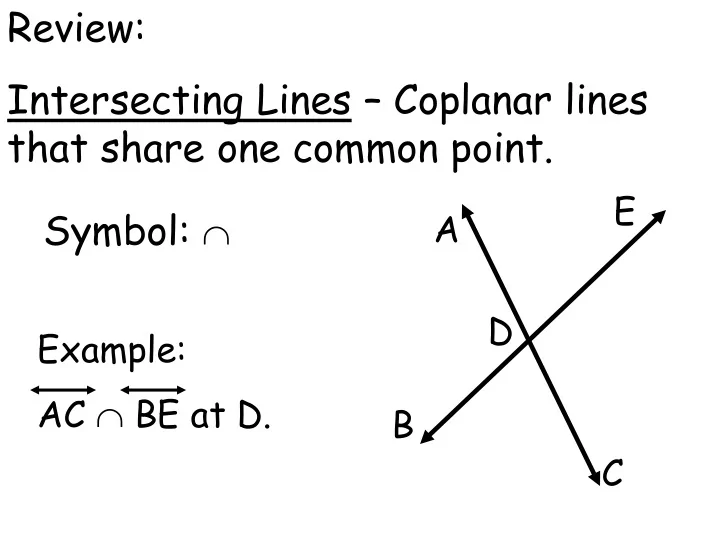

Review: Intersecting Lines – Coplanar lines that share one common point. E Symbol: A D Example: AC BE at D. B C
Lines that intersect to form right angles. A Symbol: ^ Example: B D BD ^ AC C
Three or more lines that intersect at the same point. D A F Example: K B AG, BF, and DH are G H concurrent lines and intersect at point K.
Definition – coplanar lines that do not intersect Symbol: // B D Example: A C AB // CD
Example Definition – noncoplanar lines. Therefore, they are neither parallel, nor G F intersecting. E D EG and AB are skew lines H C A B
Definition – planes that do not intersect. G F E Examples: D GFDE and HCBA H GHAE and DBCF C A B
Check for Understanding G F 1. Two parallel lines. E D 2. Two parallel planes. H C 3. Two skew lines. A B 4. Two intersecting planes. Figure is a cube. 5. Two intersecting lines. 6. Three concurrent lines. Name each figure using 7. Four coplanar points. proper notation. 8. Two perpendicular lines.
G Check for Understanding F 1. ED DB Point D E D 2. EDFG DFCB DF H C 3. Classify GE and DF. Parallel A B Figure is a cube. Skew 4. Classify GE and DB. 5. Classify GE and EA. Intersecting or Perpendicular Parallel 6. Classify GE and BC.
Definition – a line that intersects two or more coplanar lines in different points. Note: the “two or more coplanar lines” do NOT have to be parallel.
When two lines cut by a transversal several pairs of angles are formed.
2 1 Corresponding Angles
3 1 Alternate Interior Angles
5 4 Alternate Exterior Angles
6 1 Same Side Interior Angles
2 4 Same Side Exterior Angles
5 2 3 6 7 1 8 4
Recommend
More recommend